NATO in the Arctic. Potential, problems, lag
Reasons for competition
The interest of different countries in the Arctic has several main reasons. Some of them attract only certain countries of the region, while others may be interested in other states. All of these causes and factors are related to the economy, politics, and military plans.
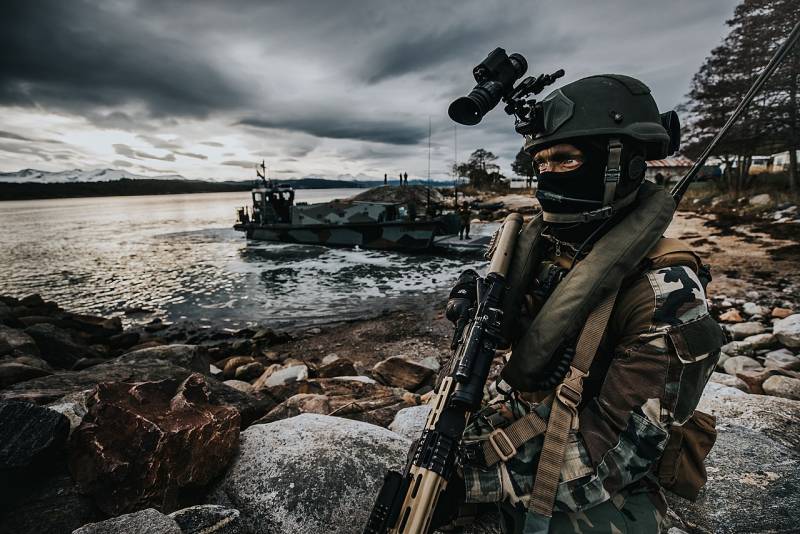
Fighters of the army of the Netherlands on the exercises Trident Juncture 2018. Photo Ministry of Defense of the Netherlands / defensie.nl
First of all, the Arctic Ocean’s waters attract the military. Large ice-covered areas can be used as convenient positioning areas for deploying strategic submarine-launched missile carriers. Modern submarines can remain under the ice for a long time, while their search in such conditions is extremely difficult. In addition, the ocean and the nearest seas can accelerate the transfer of warships to the desired areas of the Northern Hemisphere.
The second reason for interest in the Arctic is mineral reserves. Some deposits are already being developed, but most of them are still intact. In the future, as the explored and developed fields are developed, states and private organizations will show increasing interest in new facilities in the Arctic. At the same time, the question of the ownership of new fields must be addressed now.
Another major factor in the Arctic context is the Northern Sea Route. This sea route allows you to optimize transportation between Europe and Asia - it is approximately twice as short as the route passing through the Indian Ocean and the Suez Canal. The acceleration of traffic gives a certain benefit, although it is associated with some difficulties.
In the context of the Northern Sea Route, there is another curious factor that does not go unnoticed by NATO. This route is located within the exclusive economic zone of Russia, and Moscow is introducing new rules for its passage. Now third countries are obliged to notify Russia of their intention to conduct trials on the Northern Sea Route. In case of violation of these regulations, the vessel may be detained. Thus, Russia establishes its priority in the northern seas.
NATO potential
In theory, armed forces of almost all NATO countries can be involved in operations in the Arctic and surrounding areas. However, the real possibilities of the Alliance are much more modest. The Arctic has its own characteristics that impose certain restrictions. For work in the northern latitudes, ships with the appropriate characteristics and special support vessels are required. Ground forces, in turn, need a special material part.
Directly near the polar circle there are only a few NATO countries: the USA (Alaska), Canada, Denmark (Greenland), Iceland and Norway. In these countries there are numerous ports and military bases that can be used by both their own armies and the armed forces of the allied countries. In the course of various exercises, NATO regularly works out the transfer of troops from one country to another, including to the Arctic region. As usual, the United States plays the leading role in such events, but often the "southern" NATO countries also attract to the exercises.
Thus, in the shortest possible time, various formations and units from several countries of the Alliance may arrive at the Arctic bases. We are talking about representatives of all major arms. The presence of such logistical capabilities gives NATO certain advantages, which, in turn, are a cause for concern. The probable enemy can form the required grouping of troops, whose composition is difficult to predict.
Various exercises are regularly held. So, last fall, Trident Juncture 2018 maneuvers, the largest event of its kind since 2002, were held on land and sea ranges in Norway and nearby countries. The incident with the sinking of the Norwegian frigate KNM Helge Ingstad (F 313) and numerous complaints about the poor preparation of the personnel received wide publicity. Nevertheless, the teachings were considered successful. With all the problems, they allowed us to work out the interaction of 31 armies of different countries and to identify weaknesses in the training.
A few months earlier, last spring, the next exercises of the ICEX fleets were held. As part of this event, three submarines of the United States and the UK have worked under the ice, searching for convenient places for ascent, the actual ascent, and also shooting torpedoes in difficult conditions. At the same time, a submarine service camp was set up right on the ice. The exercise showed the ability of submarine forces of NATO countries to work in a complex and priority area.
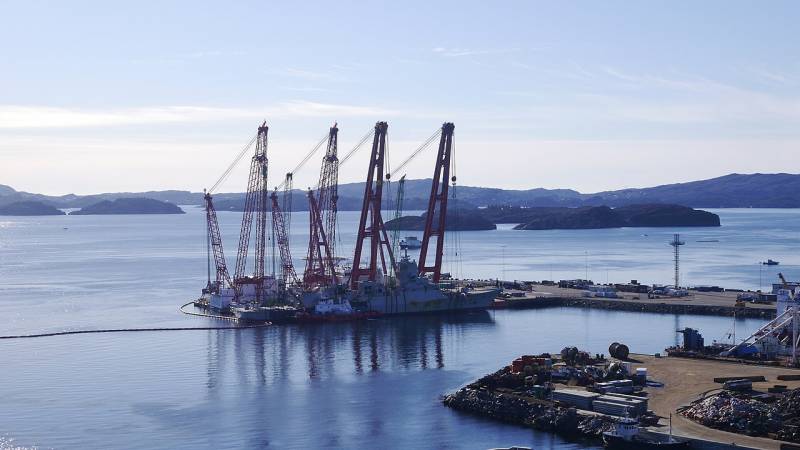
The operation to lift the frigate KNM Helge Ingstad (F313) of the Norwegian Navy is the main "victim" of the Trident Junction 2018 exercises. Photo of Wikimedia Commons
Thus, upon receipt of the corresponding task, the command of the NATO armies is able, as soon as possible, to transfer necessary units and formations to the Arctic by organizing a sufficiently powerful group. At the same time, the submarine forces of the leading countries of the Alliance are able to organize permanent duty in ice-covered water areas, which gives them a certain advantage. In parallel, groups of surface ships may enter the northern seas.
Problems, organizational and not only
However, one should not overestimate the potential of the North Atlantic alliance in the Arctic. The events of recent years vividly show that the real capabilities of NATO in the region are seriously limited by a whole set of objective factors. Upon careful consideration of the situation, it can be seen that the Alliance lacks the necessary ships and support vessels, the hardware of the ground forces does not meet the requirements, and the command and control systems for the troops are not perfect enough to operate in harsh conditions.
The specifics of the work in the Arctic and the risks associated with it can be seen on the example of several incidents that occurred during the Trident Juncture 2018 autumn maneuvers. Thus, on the eve of the start of the exercise, the USS Gunston Hall (LSD-44) landing ship of the US Navy hit a storm not far from Iceland and suffered significant damage. Because of the need for repairs, the ship could not take part in the exercises. In the early days of the Canadian Navy exercise, equipment crashed on two ships. Troubleshooting was made difficult by weather conditions.
November 8 due to problems with navigation and tracking of the situation in the shipping area the Norwegian frigate KNM Helge Ingstad (F 313) collided with a tanker. The ship with a hole managed to run aground, but later he went under water. The Norwegian Navy had to organize a special rescue operation.
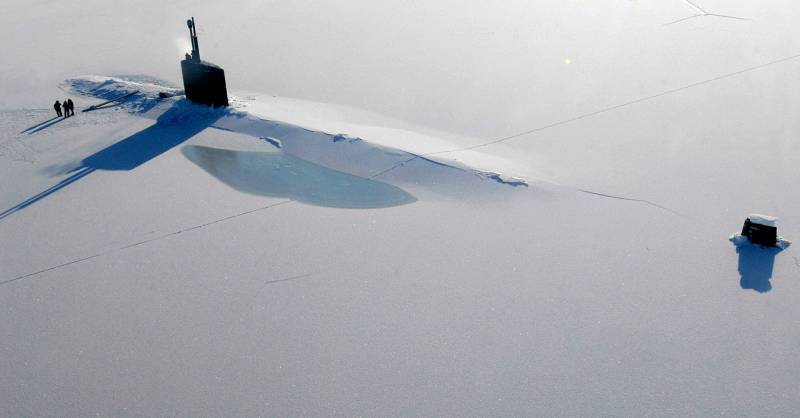
USS Annapolis Submarine (SSN-760) US Navy during the ICEX 2009 Exercise. Photo US Department of Defense
The land part of the exercise was a problem for the troops of the Netherlands and Slovenia. The fighters of these countries complained about uniforms that did not match the Norwegian climate. On the roads, there were several road accidents involving participants in maneuvers from different countries. The cause of the accident was the banal icy.
Organizing and conducting exercises is a very complicated matter, and any army is not immune from problems. However, during operations in the Arctic, any risks increase due to the special climate and inaccessibility of some areas. As shown by last year’s NATO exercises in the northern seas, one or other natural or “man-made” problems can lead to injuries or accidents, as well as to the loss of warships.
Some conclusions have already been drawn from the results of the not-so-successful NATO exercises. In the near future, special attention will be paid to uniforms of personnel, as well as preparation for work in difficult conditions of the northern latitudes. Fleet you have to learn how to work properly in areas with active shipping and respond to problems or threats.
American shortage
In the context of the potential of NATO in the Arctic, the problems of the United States in ensuring the operation of the Navy have become widely known. For effective action in the Arctic seas, the fleet needs naval bases and support vessels. The US lacks both, having the necessary infrastructure and auxiliary fleet in other regions.
It has been noted repeatedly and at different levels that the United States does not have a single large naval base of its own north of the Arctic Circle. To work in the Arctic, the US fleet has to use remote bases or use foreign ports. The bulk of the ships is fully capable of working in the Arctic, but needs the help of auxiliary vessels. First of all, icebreakers are necessary for their work.
The US Coast Guard has a fairly large icebreaking fleet, but it has only two heavy-class vessels. The USCGC Polar Star icebreaker (WAGB-10) has been serving since the mid-seventies. Its USCGC Polar Sea sisleship (WAGB-11) is in reserve from the 2010 of the year and needs to be repaired. 20 years ago, the vessel USCGC Healy (WAGB-20) was commissioned. Two heavy icebreakers meet the requirements and can navigate ships on different routes.
However, this "fleet" is not sufficient to ensure the operation of the Navy, both near the shores of the United States and away from them. Attracting two icebreakers is associated with certain organizational difficulties, since the coast guard interacts not only with the naval forces, but also with commercial shipping. Interaction with third-party icebreakers, such as Canada, is associated with the same problems.
In recent years, the need to build another new heavy icebreaker has been discussed, but this issue has been resolved only recently. In 2018, a construction financing plan worth 750 million was approved, but then this money was offered to be sent to strengthen the border with Mexico. Only this year, the construction of a new vessel was approved, and real work will begin in the foreseeable future.
The enemy does not sleep
NATO is taking various measures to enhance its potential in the Arctic, but so far the results are looking pale against the background of successes of other countries. The main competitor of the Alliance in the region is Russia, which already has a developed Arctic group, including heterogeneous forces and troops, as well as bases and means of support.
The main tasks for the protection of the Arctic borders of Russia are solved by the Joint Strategic Command "Northern Fleet". The area of responsibility of this USC includes the waters of the Arctic Ocean and its seas from the Kola Peninsula to Chukotka. The defense of the region can also involve the garrisons of the Central and Eastern military districts, covering the coast of the northern seas.
Modernization of existing facilities is underway, and new bases are being built in remote areas. Special attention is paid to the comprehensive development of the Northern Fleet. For economic and military activities on the Northern Sea Route, Russia uses a whole fleet of icebreakers. The Federal State Unitary Enterprise Atomflot, which operates four atomic icebreakers and one atomic lighter carrier, plays a special role. Four different nuclear-powered vessels are at different stages of construction and testing.
Available capabilities allow Russia to fully control strategically important areas in shipping and military terms. Thus, the proclaimed priority over the Northern Sea Route is supported by real arguments with which it is hardly worth arguing.
It should be noted that not only Russia, but also China is a competitor of NATO in the Arctic region. Back in 2012, the Chinese research vessel icebreaker Xuelong made its first voyage along the Northern Sea Route. In the near future, it was planned to build a full-fledged own icebreaking fleet and organize regular voyages of merchant ships through the northern seas. However, China carried out the first container ship with a commercial cargo only in the summer and autumn of 2018.
Judging by the open data and official statements, China considers the Northern Sea Route only as the most convenient trade route. The Polar Silk Road is half the length of the traditional route using the Indian Ocean, the Suez Canal and the Mediterranean Sea. Beijing wants to develop this area, and is ready to cooperate with Russia to obtain economic benefits.
It is predicted that in the distant future, China may also use the northern seas for the realization of its military-political interests. Indeed, he is already building an icebreaking fleet and has quite powerful naval forces. However, while the Chinese Navy are concentrated off the coast of the country and their main goal is to show the flag in the nearby seas, followed by access to the Pacific Ocean.
Thus, the "conquest" of the Arctic Ocean by the Chinese fleet so far can be attributed to a distant future. For the coming years, the Chinese Navy has more serious military tasks, while economic benefits can be obtained right now - cooperating with Russia in the field of escorting ships along routes in its exclusive economic zone.
NATO against objective factors
The Arctic is of great interest to NATO as a whole and to individual member countries for a variety of reasons. This region is important economically, politically and militarily. The countries of the Alliance already control part of the Arctic region - near their shores and borders. At the same time, it is in the interests of NATO to expand the zones of total control, which will provide for obtaining certain advantages and benefits.
However, NATO faces serious problems of various kinds that seriously reduce real potential. First of all, the work is hampered by a specific climate that impedes the activity, and also requires the involvement of special equipment and other materiel. Also, there are special requirements for competent management and organization. An additional factor hindering the achievement of goals is the success of foreign countries in the economic and military development of the Arctic.
Thus, to get all the desired results and benefits, the North Atlantic Alliance needs to solve a number of complex tasks. It is necessary to ensure the full and free activity of the ground forces, air force and navy in northern latitudes due to new types of equipment and proper organization of work. At the same time, it is necessary to prepare for a confrontation with a probable adversary who has serious advantages in the development of the region.
According to various forecasts, in the foreseeable future a real struggle for the Arctic may begin, and the winner of this confrontation will receive the most serious advantages in all spheres. As is clear now, not all potential participants in the struggle can count on an easy victory. If NATO countries want to dominate the region, they will have to work hard and improve their armed forces for the future struggle.
Based on:
https://uscg.mil/
https://navy.mil/
https://tass.ru/
https://ria.ru/
https://nationalinterest.org/
https://news.usni.org/
https://naval-technology.com/
https://flot.com/
http://iecca.ru/
http://morvesti.ru/
IISS The Military Balance 2018
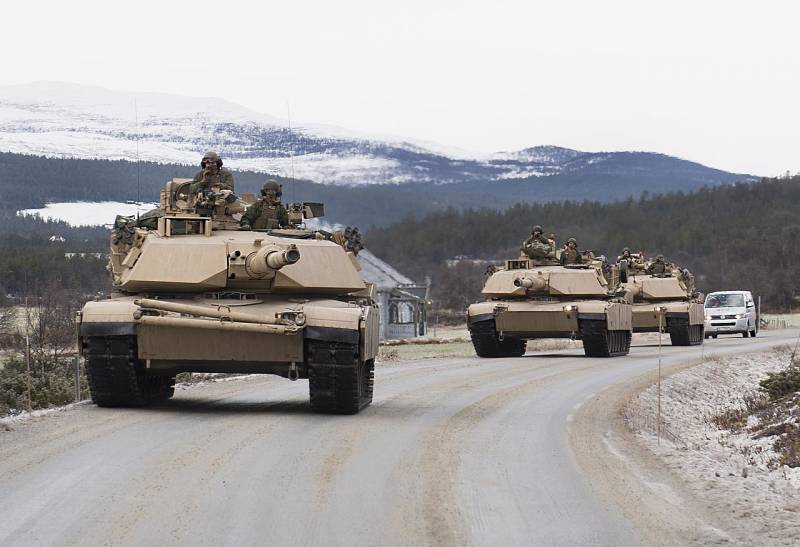
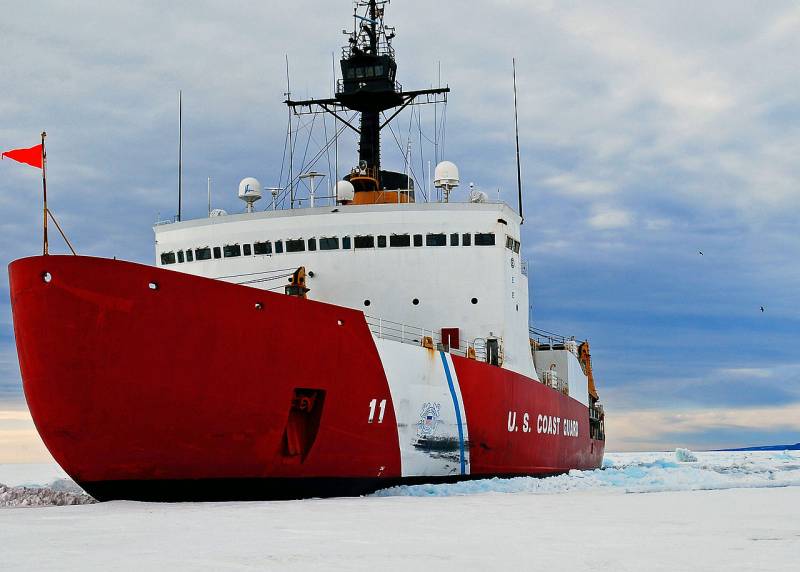
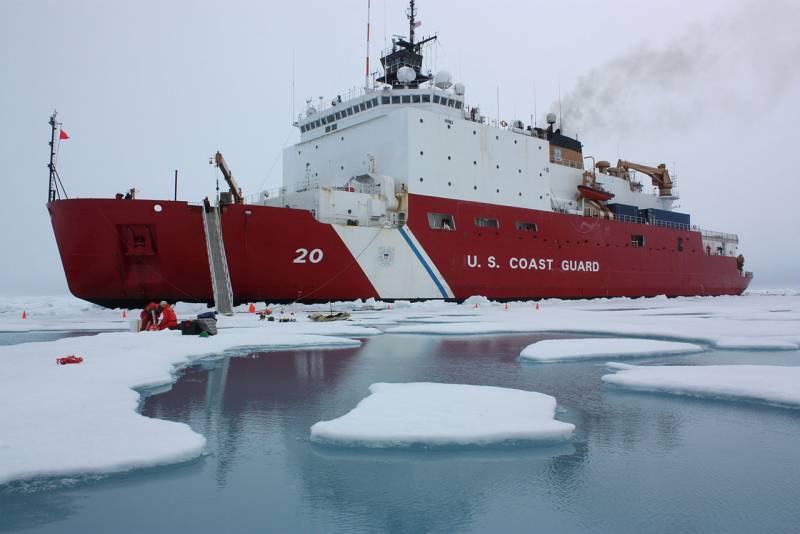
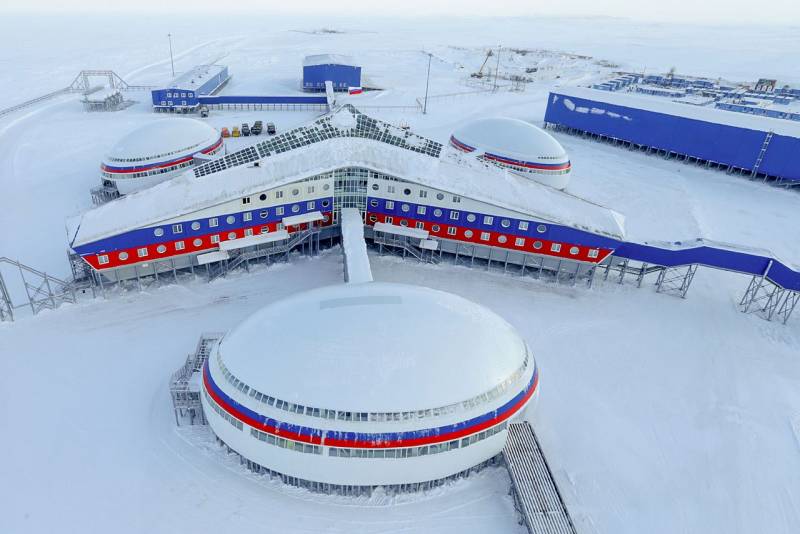

Information